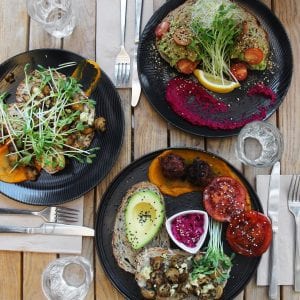I am an avid foodie, meaning that I spend ~almost~ as much time on deciding which quaint cafe or gourmet dining location to visit as I do on mapping out which landmarks are a must-see during my time abroad. In truth, it’s embarrassing to admit that finding the best spots in the city to eat is a priority. But food is its own art in a sense: a medley of spices, flavorings, and other specialties that create a holistic dish from a mere idea. I follow food-centric blogs for fun, and I love learning about where ingredients come from, (which is especially cool when it’s locally sourced), new developments in the culinary world, and simply getting to taste the chef’s vision come to life by appreciating the work that went into the production process of the meal. For me, food reveals a country’s culture, and it was exciting to eat everyday at places that are so far from my home in Texas. Here are a few takeaways from my experience:
- Food is generally cheaper & more well-presented than in the states. Once you take into account the price conversion with the weaker Australian dollar, eating out is at least as affordable, if not more, than in cosmopolitan cities in the US such as New York or Chicago. In addition, the no-tip custom “saves” you a lot of money, so take advantage! And for seemingly no reason at all, Oz plates extraordinarily well. There are frequent embellishments of edible flowers and thoughtful placement of sauces. Your meal will always be Instagram-worthy.
- Don’t be afraid to try exotic meats or fruit. Being on the other side of the world brings more variety in the ingredients. I’ve had friends who have tried alligator and crocodile meat without any regrets, and I can’t wait to do so once I journey through the east coast. However, a nontypical animal that I did eat out of curiosity was kangaroo! Roo meat is sold at most grocery stores, including Coles, and can be found in restaurant menus as well. It’s a delicious combination of beef and lamb in taste, while having the texture of a juicy steak. Before flinching, I would keep in mind that though this marsupial seems rare to Americans, it’s native to Australia and outnumbers humans 2 to 1 in this country, and it’s booming population has gotten to the point where experts are encouraging the consumption of more roo meat (news.com.au). Beyond that, I recommend doing some digging in farmer markets for boysenberries, passionfruit, finger limes, and lychees… just to name a few suggestions for Australia’s wide array of tropical fruit.
- Many, if not a majority of food establishments, are cafes. To elaborate, these cafes provide great options for breakfast, brunch, and lunch, in addition to likely having coffee and pastries, but most of them close at 3-4pm. When dinner rolls around, a longer walk might be necessary. I’ve heard that cafes are common in Europe, but being from the US, I was not expecting most places to be closed that early.
- Lastly, ask Australians how to prepare dishes that are popular in this country. If you haven’t seen the Buzzfeed video of foreigners attempting to eat Australian food and making it completely wrong, it is worth a watch for their reaction (note: vegemite is not meant to be eaten by the spoonful, especially if you are a first-timer). All the assumptions I had on how to properly eat vegemite toast, or make a cup of milo went out the window, because it is simply not the same as treating vegemite like Nutella or milo like hot cocoa mix.
Without further ado, here are some photos of my favorite meals I’ve had in Australia:




Is there any restaurant in Australia where I can eat Vegetarian Food. Does anyone offer the Best Yoga Diet in Australia?